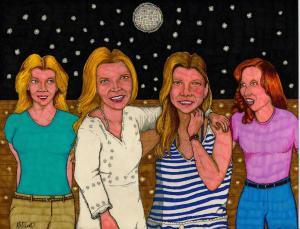
"National Women's History Month"
INT. ROUNDTABLE. DAY
FADE IN
Narrator
Did you know March is considered Women's History Month? Bet you don't know how this celebration originated, do you? Let's go all the way back to 1972 and a Northern California high school classroom. There a student asks:
Student
What is the Women's Movement?
Narrator
At that time, little information was known about the history of half the population. Oh, Gloria Steinem and Dorothy Pitman Hughes launched their Ms. magazine and Shirley Chisholm had become the first Black American woman to seek a major party's Presidential nomination. Enter Molly MacGregor, an 11th-grade history teacher with a curious student.
Molly MacGregor
What was significant to me was that I had never asked my mother, who was dead at that time, about her own life.
Narrator
Molly MacGregor's 1972 experience, in a roundabout manner, led to the creation of Women's History Month after a series of chance encounters with four other Sonoma County women. Together, they established a school curriculum on women's history. Next, they founded a nonprofit organization, and even persuaded the United States President to recognize the role of women every year.
Molly MacGregor
My whole life has been about promoting women.
Narrator
In 1974, while a graduate student at Sonoma State University, Molly MacGregor met Paula Hammett and Bette Morgan. Paula Hammett created a presentation about women's history that would be shown in classrooms, nursing homes, and union halls.
Paula Hammett
We were trying to tell the stories that at that point very few people knew or remembered.
Narrator
In 1977, Molly MacGregor, Paula Hammett, Maria Cuevas, and Bette Morgan, while working with the Sonoma County Education Task Force met Mary Ruthsdotter. This was where the four women developed Women's History Week.
Molly MacGregor
We were starting from ground zero and didn't know it.
Narrator
The women decided their theme week would coincide with March 8, which is regarded as International Women's Day. This occurrence was first established in 1911. With the assistance of a federal grant through the Women's Educational Equity Act, they expanded their mission and their Sonoma County Women's History Week grew into a parade through downtown Santa Rosa in 1979. National Women's History Week would follow after Molly MacGregor promoted her work at a women's symposium at Sarah Lawrence College in Yonkers, New York.
Molly MacGregor
We kept at our goal.
Narrator
In 1980 the group formed the National Women's History Project. This became the National Women's History Alliance and Molly MacGregor received a telephone call from the White House from Sarah Weddington, who represented Norma McCorvey, as "Jane Roe" in the famous Us Supreme Court case Roe v. Wade. Sarah Weddington told Molly MacGregor that President Jimmy Carter wanted to have a national Women's History Week in March.
In 1987, Congress officially designated March as Women's History Month. As Paul Harvey himself would say, "Now you know the rest of the story." Until the next time.
FADE OUT
|
Author Notes
Friends, by MKFlood, selected to complement my script.
So, Thanks MKFlood, for the use of your picture. It goes so nicely with my script.
|
|



